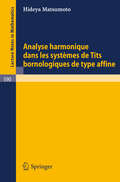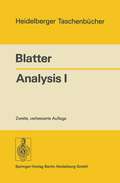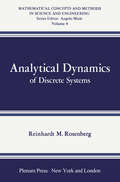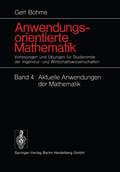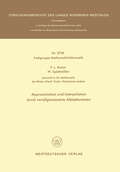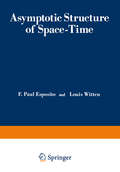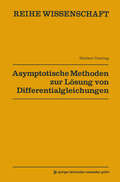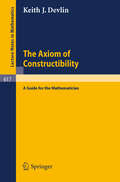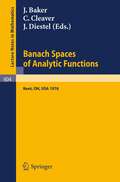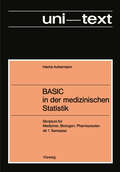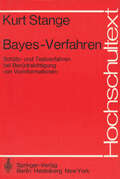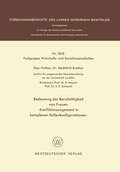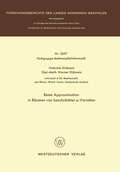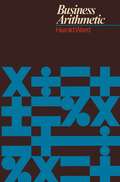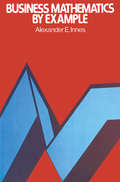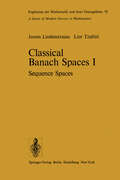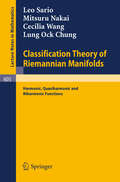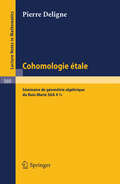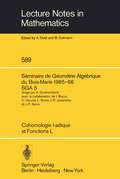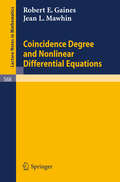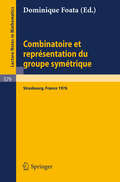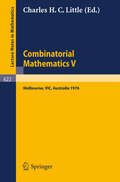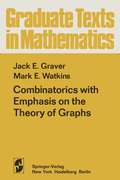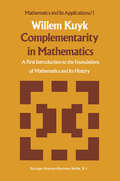- Table View
- List View
Analyse Harmonique dans les Systemes de Tits Bornologique de Type Affine (Lecture Notes in Mathematics #590)
by H. MatsumotoAnalytical Dynamics of Discrete Systems (Mathematical Concepts and Methods in Science and Engineering)
by R. RosenbergThis book is to serve as a text for engineering students at the senior or beginning graduate level in a second course in dynamics. It grew out of many years experience in teaching such a course to senior students in mechanical engineering at the University of California, Berkeley. While temperamentally disinclined to engage in textbook writing, I nevertheless wrote the present volume for the usual reason-I was unable to find a satisfactory English-language text with the content covered in my inter mediate course in dynamics. Originally, I had intended to fit this text very closely to the content of my dynamics course for seniors. However, it soon became apparent that that course reflects too many of my personal idiosyncracies, and perhaps it also covers too little material to form a suitable basis for a general text. Moreover, as the manuscript grew, so did my interest in certain phases of the subject. As a result, this book contains more material than can be studied in one semester or quarter. My own course covers Chapters 1 to 5 (Chapters 1,2, and 3 lightly) and Chapters 8 to 20 (Chapter 17 lightly).
Anwendungsorientierte Mathematik: Vorlesungen und Übungen für Studierende der Ingenieur- und Wirtschaftswissenschaften Aktuelle Anwendungen der Mathematik
by Gert Böhme H. Kernler H.-V. Niemeier D. PflügelApproximation und Interpolation durch verallgemeinerte Abtastsummen (Forschungsberichte des Landes Nordrhein-Westfalen #2708)
by Paul L. ButzerAsymptotic Structure of Space-Time
by F. EspositoThe Symposium on Asymptotic Structure of Space-Time (SOASST) was held at the University of Cincinnati, June 14-18, 1976. We had been thinking of organizing a symposium on the properties of "in finity" for several years. The subject had reached a stage of maturity and had also formed a basis for important current investi gations. It was felt that a symposium, together with a publication of the proceedings, would review, summarize, and consolidate, the more mature aspects of the field and serve as an appropriate intro duction to an expanding body of research. We had from the first the enthusiastic support and encouragement of many colleagues; with their cooperation and advice, the Symposium acquired its final form. These proceedings will attest to the value of the Symposium. The Symposium consisted of thirty lectures and had an attendance of approximately one hundred and thirty. The final impetus to our decision to go forward was the Bicen tennial Anniversary of the independence of our country. A most appropriate celebration on a University Campus surely is an intel lectual Symposium which pays honor to the histories and traditional purposes of a University. The Symposium was supported financially by the University of Cincinnatl Bicentennial Committee, the National Science Foundation, the Gravity Research Foundation, and by Armand Knoblaugh, Professor Emeritus of Physics of the University of Cincinnati.
Asymptotische Methoden zur Lösung von Differentialgleichungen (Reihe Wissenschaft)
by Herbert GoeringDas vorliegende WTB stellt eine Einführung in die Theorie der asymptotischen Methoden zur Lösung von Differentialgleiehungsproblemen dar. Mit den Grund fragen dieser Problematik beschäftigte man sich bereits in der zweiten Hälfte des vorigen Jahrhunderts. In den letzten 20 Jahren haben wichtige Anwendungsfälle der Physik und Technik das Studium der asymptotischen Methoden wieder in den Mittelpunkt des Interesses ge rückt und Anlaß zur Ausarbeitung einer nunmehr an wendungsreifen Theorie gegeben. Zur stärkeren Nutzung dieser Methoden kommt es gegenwärtig darauf an, sie in ihren Grundzügen einem breiteren Kreis von Anwendern zugänglich zu machen. Diese Aufgabe soll das WTB er füllen. Es wendet sich daher vorwiegend an in der Praxis tätige Ingenieure, Physiker und Mathematiker. In der Ausbildung kann es zur Gestaltung von Seminaren dienen. Da die exakte Lösung von Differentialgleichungen nur in Sonderfällen gelingt, besitzen die Näherungsmethoden eine große Bedeutung. Im wesentlichen unterscheidet man numerische und asymptotische Näherungsmethoden. Bei der angenäherten Lösung von Differentialgleichungs problemen haben sich die numerischen Methoden im all gemeinen bewährt. Benutzt man sie jedoch zur approxi mativen Berechnung der Lösungen von Differential gleichungen in Umgebung von Singularitäten, so werden sie meistens instabil. Bei derartigen Problemen sind die asymptotischen Näherungsmethoden geeigneter. Aus methodischen Gründen wurde eine der Zielstellung dieses WTB entsprechende einfache Darstellung gewählt.
The Axiom of Constructibility: A Guide for the Mathematician (Lecture Notes in Mathematics #617)
by K. J. DevlinBanach Spaces of Analytic Functions.: Proceedings of the Pelzczynski Conference Held at Kent State University, July 12-16, 1976. (Lecture Notes in Mathematics #604)
by G. Bennett S. Y. Chang D. E. Marshall J. A. Cima W. Davis W. J. Davis W. B. Johnson J. B. Garnett J. Johnson J. Wolfe H. E. Lacey D. R. Lewis A. L. Matheson P. Orno J. W. Roberts R. Rochberg B. Russo S. Scheinberg J. H. Shapiro M. A. Smith F. Sullivan C. StegallWith contributions by numerous experts
BASIC in der medizinischen Statistik: Skriptum für Mediziner, Biologen, Pharmazeuten ab 1. Semester
by Hanns AckermannBayes-Verfahren: Schätz- und Testverfahren bei Berücksichtigung von Vorinformationen (Hochschultext)
by K. StangeBedeutung der Berufstätigkeit von Frauen: Konfliktmanagement in komplexen Rollenkonfigurationen (Forschungsberichte des Landes Nordrhein-Westfalen #2618)
by Mechthild BrothunBeste Approximation in Räumen von beschränkter p-Variation (Forschungsberichte des Landes Nordrhein-Westfalen #2697)
by Gabriele DickmeisBoundary Value Problems for Linear Evolution Partial Differential Equations: Proceedings of the NATO Advanced Study Institute held in Liège, Belgium, September 6–17, 1976 (Nato Science Series C: #29)
by H. G. GarnirMost of the problems posed by Physics to Mathematical Analysis are boundary value problems for partial differential equations and systems. Among them, the problems concerning linear evolution equations have an outstanding position in the study of the physical world, namely in fluid dynamics, elastodynamics, electromagnetism, plasma physics and so on. This Institute was devoted to these problems. It developed essentially the new methods inspired by Functional Analysis and specially by the theories of Hilbert spaces, distributions and ultradistributions. The lectures brought a detailed exposition of the novelties in this field by world known specialists. We held the Institute at the Sart Tilman Campus of the University of Liege from September 6 to 17, 1976. It was attended by 99 participants, 79 from NATO Countries [Belgium (30), Canada (2), Denmark (I), France (15), West Germany (9), Italy (5), Turkey (3), USA (14)] and 20 from non NATO Countries [Algeria (2), Australia (3), Austria (I), Finland (1), Iran (3), Ireland (I), Japan (6), Poland (1), Sweden (I), Zair (1)]. There were 5 courses of_ 6_ h. ollI'. s~. 1. nL lJ. , h. t;l. l. I. rl"~, 1. n,L ,_ h. t;l. l. I. r. !'~ , ?_ n. f~ ?_ h,,
Classical Banach Spaces I: Sequence Spaces (Ergebnisse der Mathematik und ihrer Grenzgebiete. 2. Folge #92)
by J. Lindenstrauss L. TzafririThe appearance of Banach's book [8] in 1932 signified the beginning of a syste matic study of normed linear spaces, which have been the subject of continuous research ever since. In the sixties, and especially in the last decade, the research activity in this area grew considerably. As a result, Ban:ach space theory gained very much in depth as well as in scope: Most of its well known classical problems were solved, many interesting new directions were developed, and deep connections between Banach space theory and other areas of mathematics were established. The purpose of this book is to present the main results and current research directions in the geometry of Banach spaces, with an emphasis on the study of the structure of the classical Banach spaces, that is C(K) and Lip.) and related spaces. We did not attempt to write a comprehensive survey of Banach space theory, or even only of the theory of classical Banach spaces, since the amount of interesting results on the subject makes such a survey practically impossible.
Classification Theory of Riemannian Manifolds: Harmonic, Quasiharmonic and Biharmonic Functions (Lecture Notes in Mathematics #605)
by S. R. Sario M. Nakai C. Wang L. O. ChungCohomologie Etale: Séminaire de Géométrie Algébrique du Bois-Marie SGA 4 1/2 (Lecture Notes in Mathematics #569)
by Pierre Deligneltats – avec une généralité minimale, souvent insuffisante pour les applications –et une idée de leur démonstration. Pour des résultats complets, ou des démonstrationsdétaillées, SGA 4 reste indispensable.Le “Rapport sur la formule des traces” contient une démonstration complété dela formule des traces pour l’endomorphisme de Frobenius. La démonstration est celledonnée par Grothendieck dans SGA 5, élaguée de tout détail inutile. Ce rapportdevrait permettre à utilisateur d’oublier SGA 5, qu’on pourra considérer comme unesérie de digression, certaines très intéressantes. Son existence permettra de publierprochainement SGA 5 tel quel. Il est complété par l’exposé “Applications de laformule des traces aux sommes trigonométriques” qui explique comment la formuledes traces permet l’étude de sommes trigonométriques, et donne des exemples..
Cohomologie l-adique et Fonctions L: Séminaire de Géométrie Algébrique du Bois-Marie 1965-66, SGA 5 (Lecture Notes in Mathematics #589)
by Ionel Bucur Alexander Grothendieck Christian Houzel Luc Illusie Jean-Pierre Jouanolou Jean-Pierre SerreCoincidence Degree and Nonlinear Differential Equations (Lecture Notes in Mathematics #568)
by R. E. Gaines J. L. MawhinCombinatoire et Representation du Groupe Symetrique: Actes de la Table Ronde du C.N.R.S., tenue a l'Universite Louis Pasteur, Strasbourg, 26 au 30 avril 1976 (Lecture Notes in Mathematics #579)
by D. FoataCombinatorial Mathematics V.: Proceedings of the Fifth Australian Conference, Held at the Royal Melbourne Institute of Technology, August 24 - 26, 1976. (Lecture Notes in Mathematics #622)
by C. H. C LittleCombinatorics with Emphasis on the Theory of Graphs (Graduate Texts in Mathematics #54)
by J. E. Graver M. E. WatkinsCombinatorics and graph theory have mushroomed in recent years. Many overlapping or equivalent results have been produced. Some of these are special cases of unformulated or unrecognized general theorems. The body of knowledge has now reached a stage where approaches toward unification are overdue. To paraphrase Professor Gian-Carlo Rota (Toronto, 1967), "Combinatorics needs fewer theorems and more theory. " In this book we are doing two things at the same time: A. We are presenting a unified treatment of much of combinatorics and graph theory. We have constructed a concise algebraically based, but otherwise self-contained theory, which at one time embraces the basic theorems that one normally wishes to prove while giving a common terminology and framework for the develop ment of further more specialized results. B. We are writing a textbook whereby a student of mathematics or a mathematician with another specialty can learn combinatorics and graph theory. We want this learning to be done in a much more unified way than has generally been possible from the existing literature. Our most difficult problem in the course of writing this book has been to keep A and B in balance. On the one hand, this book would be useless as a textbook if certain intuitively appealing, classical combinatorial results were either overlooked or were treated only at a level of abstraction rendering them beyond all recognition.
Complementarity in Mathematics: A First Introduction to the Foundations of Mathematics and Its History (Mathematics and Its Applications #1)
by W. KuykAs long as algebra and geometry The unreasonable effectiveness of proceeded along separate paths, mathematics in science . . . Eugene Wigner their advance was slow and their applications limited. But when these sciences joined Weil, if you knows of a better 'oie, company, they drew from each go to it. Bruce Bairnsfather other fresh vitality and thence forward marched on at a rapid pace What is now proved was once only towards perfeetion. imagined. Wi1liam Blake J oseph Louis Lagrange Growing specialization and diversification have brought a host of monographs and textbooks on increasingly specialized topics. However, the 'tree' of knowledge of mathematics and related fields does not grow only by putting forth new branches. It also happens, quite often in fact, that branches which were thought to be completely disparate are suddenly seen to be related. This series of books, Mathematics and Its Applications, is devoted to such (new) interrelations as exempla gratia: - a central concept which plays an important role in several different mathematical and/or scientific specialized areas; Editor's Preface 8 - new applications of the results and ideas from one area of scientific endeavor into another; - influences which the results, problems and concepts of one field of inquiry have and have had on the development of another. With books on topics such as these, of moderate length and price, which are stimulating rather than definitive, intriguing rather than encyclopaedic, we hope to contribute something towards better communication among the practitioners in diversified fields.
